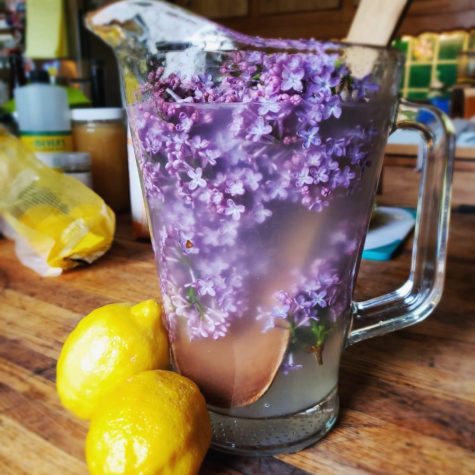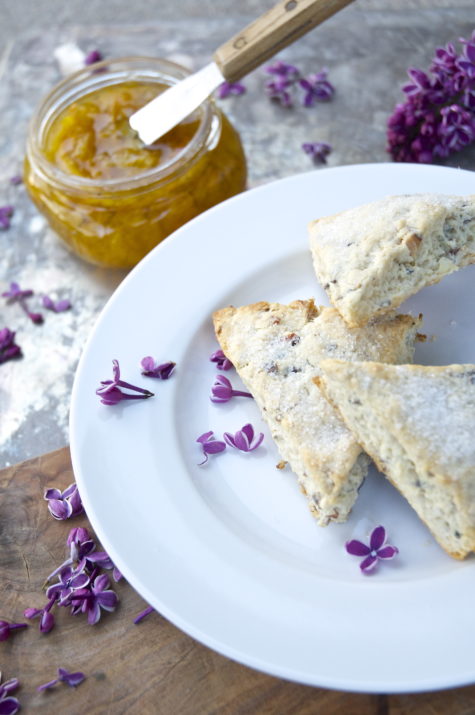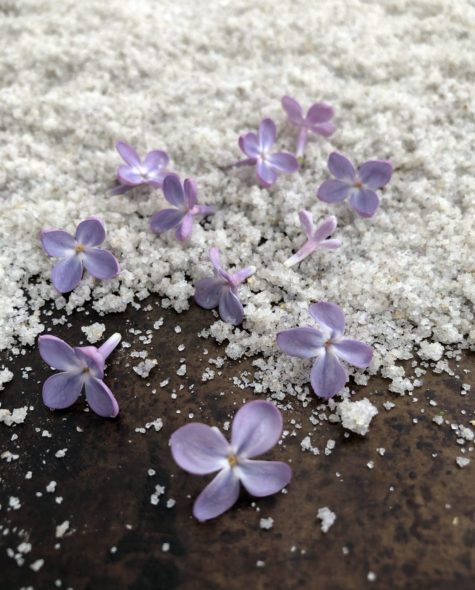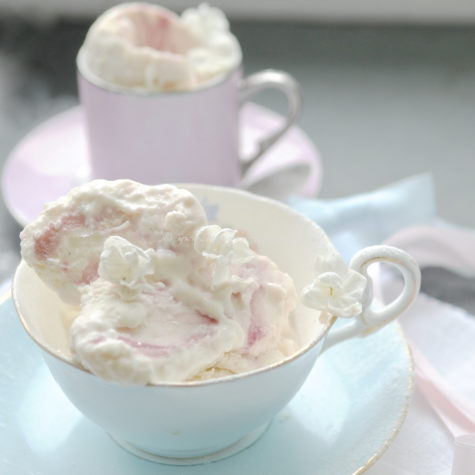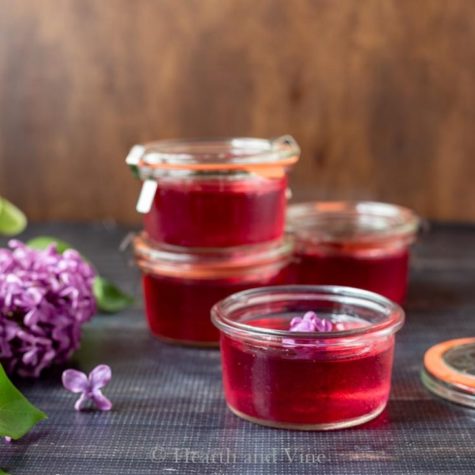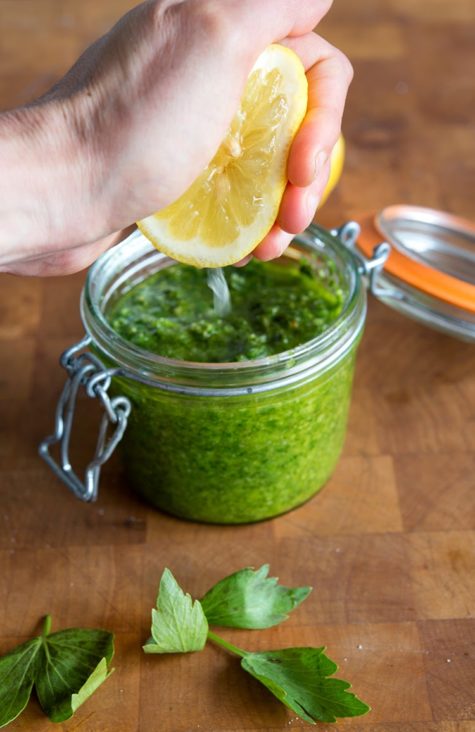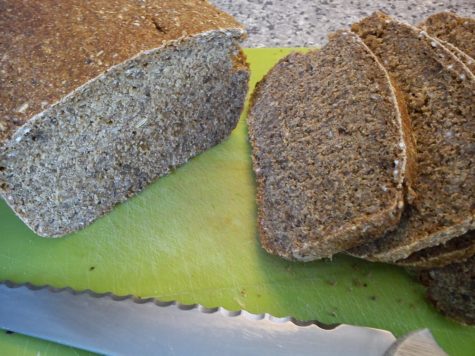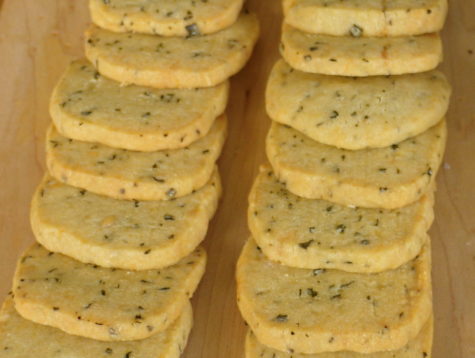Monthly Archives: June 2020
Lilac Lemonade
Lilac lemonade is very easy to make. If you have ever had lavender lemonade, this lemonade actually tastes very similar.
To make this easy lemonade, you will need about 2 cups of fresh Lilac blossoms. Make sure to pick Lilacs that have not been sprayed with any chemicals. Wash them to remove any insects and gently pull off the Lilac blossoms to make two cups.
Ingredients:
- 2 cups fresh Lilac blossoms
- 1 cup sugar or honey
- 16 cups water
- Juice of 4 lemons
To really get the flavor of the Lilac blossoms, you will need to boil the blossoms like you would to make tea. Place the Lilac blossoms in a sauce pan and cover them with water. Bring the water to a boil.
Remove the pan from the heat and let it sit for about 20 minutes. The longer you let it sit, the stronger the Lilac flavor will be. Strain the Lilac blossoms out of the water with a fine mesh strainer.
Place the liquid in a 1 gallon container and add the sugar or honey, lemon juice, and remaining water. Stir. Refrigerate until ready to serve. Garnish with a sprig of fresh Lilac flowers if desired.
You can also freeze fresh Lilac flowers in water in an ice cube tray, putting 2 or 3 of the tiny florets in each cube. This makes a cute way to dress up your Lilac Lemonade.
Notes:
This recipe is made with fresh Lilac blossoms. If you want to preserve your Lilac blossoms to make Lilac lemonade when your Lilacs are out of season, then see the the following posts for:
This recipe makes approximately 1 gallon of lemonade. You can cut the recipe in half, and you can also adjust the recipe to suit your tastes if you would like to use less sugar or more lemon juice.
Found at: Creative Homemaking
Lilac Blossom Scones
Ingredients:
- 3 cups flour, all-purpose
- 1/3 cup sugar
- 2 1/2 teaspoons baking powder
- 1/2 teaspoon baking soda
- One teaspoon salt
- 12 tablespoons unsalted butter, chilled
- 1 cup buttermilk, shaken well
- One teaspoon vanilla extract
- 1/2 cup toasted, chopped almonds
- 1 cup lilac flowers
Preheat your oven to 425 degrees.
In a large mixing bowl, combine the flour, sugar, baking powder, baking soda, and salt. Whisk the ingredients together. Cut the chilled butter into small cubes and toss into the dry mixture. Using your fingers and hands, work the butter into the flour mixture, until pea-sized lumps of butter are present.
Add the buttermilk, vanilla extract, almonds, and lilac blossoms. Fold together in the bowl. I kneaded the dough by hand, making sure to not over-work.
Gather and roll the dough into a ball. Lightly flour the ball of dough and flatten it out, by hand, into a 1/2 inch thick disk. Cut the dough into triangles and place onto a greased baking sheet.
Lightly dust with raw sugar. I greased my sheet with butter. Bake 12 to 16 minutes, until desired level of toastiness.
Found at: Holly and Flora
Lilac Sugar
How easy is this?
All you need is equal parts fully opened lilac blossoms, green stems removed, and granulated sugar.
Blend in a food processor till the blossoms have completely broken down. The finished sugar will be moist due to the moisture content of the fresh blossoms, so lay out the sugar on a parchment lined baking sheet and let them air dry.
You can speed up the process by heating the oven to 200 F, placing the baking sheet on the center rack, and then turning off the heat. In no time the sugar will be dried out. It will be a tad clumpy, so just give it another whiz in the food processor. Or you can just do so by hand using a mortar and pestle.
Et voila, the most fragrant sugar you will ever come across! Even as it was drying out in the oven, the kitchen was already taking on a lovely perfume. I had enough for my pie, as well as for tea for the next little while! I also added a few crushed lilac petals to the ground sugar, just for color and added texture.
From: Food 52
Lilac Ice Cream
Fragrant and sweet. Who can resist this? Here’s what you will need:
- about 100 lilac florets
- 150ml milk
- 25g sugar
- pinch of salt
- 2 egg yolks
- 200ml heavy cream
Pick the florets off a bloom of lilac and rinse them. Warm the milk, sugar, salt and lilac florets in a small, heavy saucepan over a medium heat, stirring to dissolve. Remove from the heat when the milk is starting to steam and before it actually starts to simmer.
Taste at this point to check the level of lilac flavor, remembering that the flavor will dissipate somewhat with the addition of the other ingredients. For a stronger flavor, leave the mixture to infuse and taste periodically.
When ready, strain off the lilac florets and warm (but don’t simmer) the mixture again.
Break the egg yolks into a small bowl and stir them together. Gradually add some of the warmed milk to the yolks, stirring constantly, then add the warmed yolk and milk mixture back into the saucepan with the rest of the milk.
Cook the egg and milk mixture (or we can call it custard now) over a low heat, stirring frequently, until it’s thick enough to coat your spoon or spatula (this took me around 12 minutes or so). Now pour the custard mixture into the cream, stirring to combine.
Chill the mixture by sitting it in an ice bath and then freeze either using an ice cream maker, if you’ve got one, or as follows, if you don’t:
Put the mixture in a deep baking dish or bowl and place in the freezer. After about 45 minutes, once the mixture has started to freeze around the edges, remove the bowl and beat the mixture vigorously, using a whisk or a hand blender to break up any ice crystals that have started forming.
Return the mixture to the freezer and repeat this roughly every 30 minutes until the ice cream is frozen which, depending on your freezer, may take take 3-6 hours.
Instead of using sugar, it might be even more fun to sweeten the ice cream with Lilac Honey.
From: The Daily Spud
Lilac Jelly
- 2 c. packed lilac flowers
- 2 1/2 c. boiling water
Pour the boiling water over the lilac flowers, cover and allow to cool. Allow the infusion to sit 8 hours, or overnight. Strain the flowers from the liquid using a coffee filter, you should have about 2 1/4 c. liquid. This is your Lilac infusion.
- 2 c. lilac infusion
- 4 T lemon juice
- 1 box Sure-Jell powdered pectin
- 4 c. sugar
Place the lilac infusion, lemon juice and pectin in a large pot. Stirring constantly, bring the mixture to a rolling boil. Add all of the sugar at once, and stir to dissolve. Bring the jelly back up to a rolling boil for 1 minute.
Remove the jelly from the heat, skim the foam from the top (I got a lot of foam from this recipe) and ladle into hot, sterilized jars. Process in a water bath for 10 minutes. Makes 8- 4 oz jars.
From: The Three Foragers
Lilac Syrup
Pour over pancakes, add as a liquor base, or a nonalcoholic lemonade base. The extra syrup can be frozen in mason jars to keep year round. It is quite simple to make:
- 1 cup of water
- 1 cup of sugar
- 1 cup of lilac flowers (stems and green parts removed)
Combine the water and sugar over medium heat on the stove. Heat until dissolved. Add the lilac flowers and simmer for 10 minutes. If you want a brightly hued syrup, add about five blueberries. The color will pop and add a great dimension to your cocktails. Remove from heat, drain through a sieve, bottle, and store in the refrigerator.
From: Holly and Flora
Lilac Honey
Fill a jar (1/2 pint, pint, quart etc.) with freshly picked flowers with a little room at the top. Pour over honey to the top and cap. Allow to infuse for at least 6 weeks. No need to strain afterwards – eat the flowers along with the honey! Great for adding to recipes, spreading on bread, or adding to teas.
Note: Always use raw, unfiltered honey. Use local honey whenever possible.
From: The Practical Herbalist
Lovage Vinaigrette
- 1 ¼ c. olive oil
- ¾ c. white wine vinegar
- ¼ c. chive blossom petals
- 1 t. honey
- 1 t. dijon mustard
- 10 lovage leaves, chopped fine
- 2 T. parmesan cheese
- 1 T. lemon juice
Combine all and shake vigorously.
About Lovage:
Lovage is an ancient healing herb, mostly used for its diuretic properties in cases of water retention and urinary difficulties, and also for pain and swelling (inflammation) of the lower urinary tract, for preventing of kidney stones, and to increase the flow of urine during urinary tract infections.
The seeds, leaves and leaf stems have a strong, earthy, celery flavor that enriches soups and stews and is particularly useful in vegetarian dishes, with rice, vegetable stuffings and nut roasts. More info on this herb can be found at the Encyclopedia of Herbology.
Recipe: Henriette’s Herbal Homepage
Lovage Seed Brandy Bread
- 1 pkg dry yeast
- 1 tsp sugar
- 1/1/4 cups warm (not hot) water
- 2 teasp salt
- 2 1/2 cups wheat flour
- 2 1/2 cups white flour
- 1 tablespoon brandy
- 1 tablespoon vegetable oil
- 1 onion peeled and grated
- 1 tablespoon lovage seeds
Mix the yeast, sugar, and warm water together. Set aside in a warm spot until the mixture grows frothy. Sift together the flours and salt in a separate bowl. Add the oil, yeast mixture, onion, and brandy, kneading to make a soft dough.
Turn the dough onto a floured board and gently knead for 10 minutes. The dough should be smooth and elastic. Return the dough to the bowl, cover with a damp cloth, and leave to rise for 1 1/2 hours or until doubled in size.
Punch down dough, turn onto the floured surface, and knead for five minutes. Form dough into a loaf shape and place in a well-greased 9 by 5 by 2 1/2 inch loaf pan, turning once to coat all sides.
Sprinkle with lovage seeds and let rise for 15 minutes while you preheat oven to 450 degrees.
Bake approximately 30 to 40 minutes or until done.
About Lovage:
Lovage is an ancient healing herb, mostly used for its diuretic properties in cases of water retention and urinary difficulties, and also for pain and swelling (inflammation) of the lower urinary tract, for preventing of kidney stones, and to increase the flow of urine during urinary tract infections.
The seeds, leaves and leaf stems have a strong, earthy, celery flavor that enriches soups and stews and is particularly useful in vegetarian dishes, with rice, vegetable stuffings and nut roasts. More info on this herb can be found at the Encyclopedia of Herbology.
Savory Lovage Biscuits
The perfect nibble to accompany a sundowner on a warm terrace (though the chances of either warm terrace or downing sun seem slim at the moment). The original recipe is in Ottolenghi’s The Cookbook and features more cheese and some poppy seeds, but I’ve buggered about with it as is my way, and I must say it turns out not half bad:
- 210g plain flour
- 1/2 tsp baking powder
- 3 tbsp finely chopped lovage
- pinch of salt
- 165g un-salted butter, at room temperature
- 150g freshly grated parmesan
Beat the butter and cheese together well. Add all the other ingredients and mix until you have a soft dough.
Divide the dough in half and mold each half into a long block (you’re going to slice the biscuits off the block like a loaf of bread so make it as big or small as you like your biscuits). Wrap in cling film and chill for an hour.
When ready, pre-heat the oven to 170 degrees. Remove the dough from the fridge and slice into biscuits. Anything over 5mm thick is fine, anything thinner will snap. Place them on a silicone sheet a little way apart (they grow) and cook for 12-15 minutes.
Cool and serve with G&T on any terrace you can find. Makes about 40.
About Lovage:
Lovage is an ancient healing herb, mostly used for its diuretic properties in cases of water retention and urinary difficulties, and also for pain and swelling (inflammation) of the lower urinary tract, for preventing of kidney stones, and to increase the flow of urine during urinary tract infections.
The seeds, leaves and leaf stems have a strong, earthy, celery flavor that enriches soups and stews and is particularly useful in vegetarian dishes, with rice, vegetable stuffings and nut roasts. More info on this herb can be found at the Encyclopedia of Herbology.
Recipe: Gluts and Gluttony
